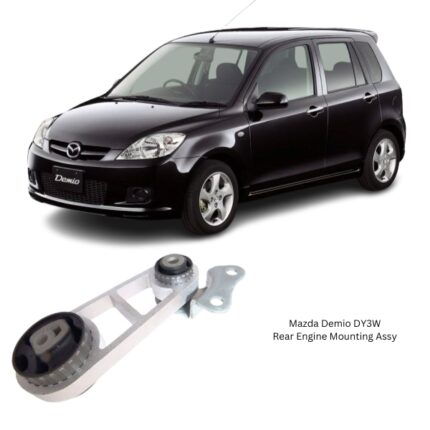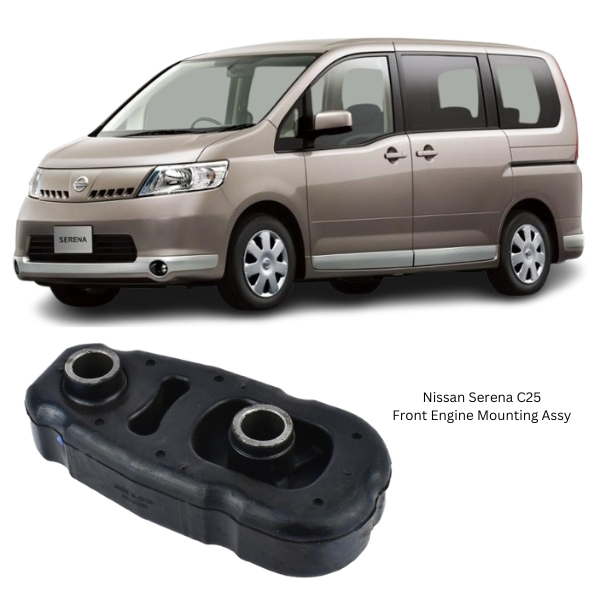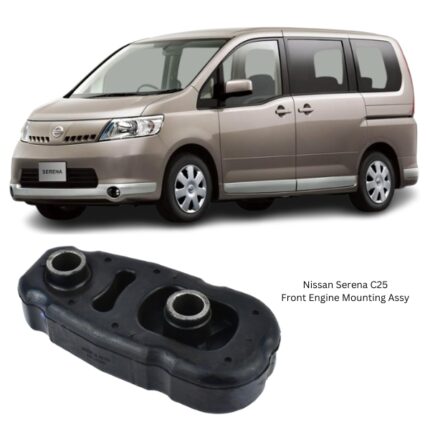Get Nissan Serena C25 Front Engine Mounting Assy 11380-EN00A in Kenya
The Front Engine Mounting Assembly is a key component in a vehicle’s powertrain support system. It is designed to secure the front section of the engine to the vehicle’s chassis while absorbing vibration, controlling engine movement, and ensuring proper alignment of the drivetrain. It plays a critical role in both structural support and ride comfort, as it prevents direct transmission of engine vibration and torque forces into the cabin and frame.
Located at the forward part of the engine bay, the front engine mount bears part of the engine’s weight and helps resist movement caused by braking, acceleration, and road irregularities. It works alongside the left-hand, right-hand, and rear mounts to distribute mechanical load and provide a stable engine position under various driving conditions.
Purpose and Function
The front engine mount does more than just hold the engine in place. It is engineered to perform a range of mechanical and comfort-related functions. These include:
-
Load Support: Carries a portion of the static and dynamic weight of the engine.
-
Vibration Isolation: Absorbs and dampens engine vibrations, preventing them from transferring to the cabin.
-
Torque Management: Controls the engine’s rocking motion under acceleration, deceleration, and shifting.
-
Engine Alignment: Maintains the correct alignment of the engine with other powertrain and suspension components.
-
Protection of Adjacent Systems: Prevents mechanical stress on exhaust systems, hoses, and wiring harnesses that could be damaged by excess movement.
By effectively fulfilling these roles, the front engine mount contributes to smoother operation, reduced noise, and prolonged engine and transmission life.
Design and Materials
The Front Engine Mounting Assembly typically consists of a combination of metal components and elastomeric or hydraulic elements. It is engineered to withstand the harsh conditions of the engine bay, including extreme temperatures, vibration, and exposure to oil, coolant, and other automotive fluids.
Common components include:
-
Steel or Aluminum Brackets
These form the structural base of the mount, bolting the engine and chassis together. -
Rubber or Polyurethane Insulator
The elastomeric core absorbs vibrations and allows slight engine movement without metal-to-metal contact. The material is selected for its flexibility and damping properties. -
Inner Bushing or Sleeve
This metallic insert allows a bolt to pass through the mount, enabling it to be securely fastened while also acting as a pivot point for controlled movement. -
Hydraulic Chamber (in some designs)
Some mounts are fluid-filled to enhance damping, particularly of low-frequency vibrations. The hydraulic fluid absorbs and dissipates energy more effectively than solid rubber alone. -
Heat Shield (optional)
A metal guard may be included to protect the rubber insulator from excessive heat emitted by nearby engine or exhaust components.
Each component is carefully designed and bonded to ensure durability under dynamic loads and environmental exposure.
Performance Characteristics
The front engine mount must meet strict performance standards to ensure the long-term reliability of the engine support system and the comfort of vehicle occupants. These performance features include:
-
Vibration Damping: Effective suppression of engine oscillations to improve ride comfort.
-
Torque Resistance: Prevents excessive engine movement under high-load conditions such as hard acceleration or braking.
-
Structural Integrity: Long-lasting resistance to tearing, cracking, or deformation under sustained pressure and thermal cycles.
-
Chemical Resistance: Ability to resist degradation from exposure to oil, grease, coolant, and road contaminants.
-
Thermal Endurance: Sustains performance across wide temperature ranges common in engine compartments.
The combination of these characteristics ensures a mount that is both reliable and capable of enhancing the overall driving experience.
Symptoms of a Worn or Failing Mount
Over time, the front engine mount may deteriorate due to age, exposure to elements, or mechanical stress. Recognizing the signs of failure early can help prevent further damage and ensure vehicle safety.
Common symptoms include:
-
Excessive Engine Vibration
Increased vibration felt in the cabin, steering wheel, or floorboard, especially at idle. -
Clunking or Knocking Sounds
Sounds occurring when shifting gears, accelerating, or going over bumps may indicate that the engine is moving excessively. -
Engine Movement or Rocking
Visual movement of the engine when revving or shifting can signal a broken or collapsed mount. -
Misalignment of Engine Components
Belts, pulleys, and hoses may appear misaligned or stretched due to engine shifting. -
Visible Mount Damage
Cracks in the rubber, separation from the bracket, or fluid leakage in hydraulic mounts are all indicators of failure.
Timely diagnosis and replacement help avoid additional strain on transmission mounts, driveshafts, and exhaust components.
Installation Procedure
Installing a front engine mounting assembly requires mechanical precision and attention to safety. Although the process can vary by vehicle, general steps are as follows:
-
Preparation and Safety
Park the vehicle on a level surface, engage the parking brake, and disconnect the battery. -
Support the Engine
Use an engine hoist or jack with a block of wood to relieve pressure from the engine mount. -
Access the Mount
Remove any components obstructing access to the front mount, such as the radiator shroud, air intake parts, or underbody covers. -
Unbolt and Remove the Old Mount
Detach the mounting bolts from both the engine side and the frame side. Remove the old mount carefully. -
Inspect Surrounding Components
Check for damage or wear on adjacent mounts and ensure no components are misaligned or stretched. -
Install the New Mount
Align and install the new mount, ensuring all bolts are tightened to the manufacturer’s recommended torque settings. -
Reassembly and Testing
Replace any removed parts, lower the engine, and test for vibrations or noises by starting the engine and observing behavior under load.
Maintenance and Inspection
Though the front engine mount does not require regular maintenance, periodic inspection during scheduled service intervals can identify early signs of degradation. Key things to look for:
-
Hardened or cracked rubber
-
Signs of fluid leakage (in hydraulic mounts)
-
Visible separation from the bracket
-
Engine tilt or misalignment
-
Abnormal noise during start-up or shut-down
Early replacement reduces the risk of secondary failures and preserves the balance of the engine support system.
Benefits of Replacing a Worn Front Mount
-
Enhanced Cabin Comfort: Eliminates harshness and vibration in the driver/passenger area.
-
Improved Engine Stability: Restores proper engine positioning and reduces torque-related movement.
-
Better Transmission Operation: Minimizes drivetrain misalignment that can lead to rough gear changes.
-
Increased Component Life: Reduces stress on related systems like the exhaust, cooling lines, and electrical wiring.
-
Quieter Operation: Eliminates knocks and thuds during gear changes or over uneven roads.
Follow us on Facebook for more parts.





Reviews
Clear filtersThere are no reviews yet.